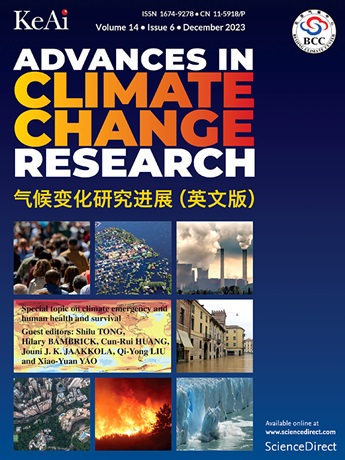Degradation of potential winter roads threatens vulnerable communities’ freight accessibility in the pan-Arctic region
IF 5.2
1区 地球科学
Q1 ENVIRONMENTAL SCIENCES
引用次数: 0
Abstract
Winter roads, which are seasonal roads built on frozen surfaces, serve as a socio-economic lifeline in the pan-Arctic region but are sensitive to amplified Arctic warming. Potential winter roads (PWRs) refer to areas where environmental conditions are suitable for forming the frozen foundation of winter roads. These roads are used to support various vehicles for diverse transportation purposes. However, PWRs for different vehicles (PWRDVs) have not been systematically identified, and the impact of changes in PWRs for freight vehicles on community freight accessibility remains unclear. This study quantified changes in PWRDVs in the pan-Arctic region during the water years 2003–2022 and assessed community freight accessibility under these changes. Results indicate that PWRs for heavier vehicles exhibited smaller areas (ranging from (6.32−8.02) × 106 km2 as multi-year averages), shorter durations (ranging from 160 to 180 d for areal and multi-year averages), and more severe degradation. Degraded PWRDVs were primarily observed in the Eurasian Arctic. PWRDV areas decreased by (1.6–3.7) × 104 km2 per year (2%–6% per decade). Shortened durations occurred in 8%–21% of PWRDVs, with average reductions of (1.30–2.03) d per year (7%–13% per decade). Some degradation trends were more pronounced than previously documented long-term trends, suggesting accelerated degradation in recent years. Without artificial improvements to other transportation infrastructure, the degradation of PWRs for freight vehicles led to reduced freight accessibility, with improvements in accessibility through PWRs decreasing by 2%–73% per decade in 155 communities, most of which were considered vulnerable due to their relatively large populations and remoteness. These findings provide insights into changes in winter roads and can help enhance the resilience of winter roads and communities to climate change in the pan-Arctic region.
潜在冬季道路的退化威胁到泛北极地区脆弱社区的货运可达性
冬季道路是在冰冻地面上修建的季节性道路,是泛北极地区的社会经济生命线,但对北极变暖的加剧很敏感。潜在冬季道路是指环境条件适宜形成冬季道路冻基的地区。这些道路用于支持各种运输目的的各种车辆。然而,不同车辆的pwr (PWRDVs)尚未被系统地确定,货运车辆pwr的变化对社区货运可达性的影响尚不清楚。本研究量化了2003-2022水年期间泛北极地区PWRDVs的变化,并评估了这些变化下的社区货运可达性。结果表明,重型车辆pwr的面积较小(多年平均值为(6.32 ~ 8.02)× 106 km2),持续时间较短(区域平均值和多年平均值为160 ~ 180 d),退化程度更严重。PWRDVs的退化主要发生在欧亚北极地区。PWRDV面积每年减少(1.6-3.7)× 104 km2(每十年减少2%-6%)。8%-21%的pwrdv持续时间缩短,平均每年减少(1.30-2.03)d(每十年减少7%-13%)。一些退化趋势比以前记录的长期趋势更为明显,表明近年来退化加速。在没有人为改善其他交通基础设施的情况下,货运车辆压水堆的退化导致货运可达性降低,155个社区通过压水堆改善的可达性每十年下降2%-73%,其中大多数社区由于人口相对较多和偏远而被认为是脆弱的。这些发现为了解冬季道路的变化提供了见解,并有助于提高泛北极地区冬季道路和社区对气候变化的适应能力。
本文章由计算机程序翻译,如有差异,请以英文原文为准。
求助全文
约1分钟内获得全文
求助全文
来源期刊

Advances in Climate Change Research
Earth and Planetary Sciences-Atmospheric Science
CiteScore
9.80
自引率
4.10%
发文量
424
审稿时长
107 days
期刊介绍:
Advances in Climate Change Research publishes scientific research and analyses on climate change and the interactions of climate change with society. This journal encompasses basic science and economic, social, and policy research, including studies on mitigation and adaptation to climate change.
Advances in Climate Change Research attempts to promote research in climate change and provide an impetus for the application of research achievements in numerous aspects, such as socioeconomic sustainable development, responses to the adaptation and mitigation of climate change, diplomatic negotiations of climate and environment policies, and the protection and exploitation of natural resources.
 求助内容:
求助内容: 应助结果提醒方式:
应助结果提醒方式:


